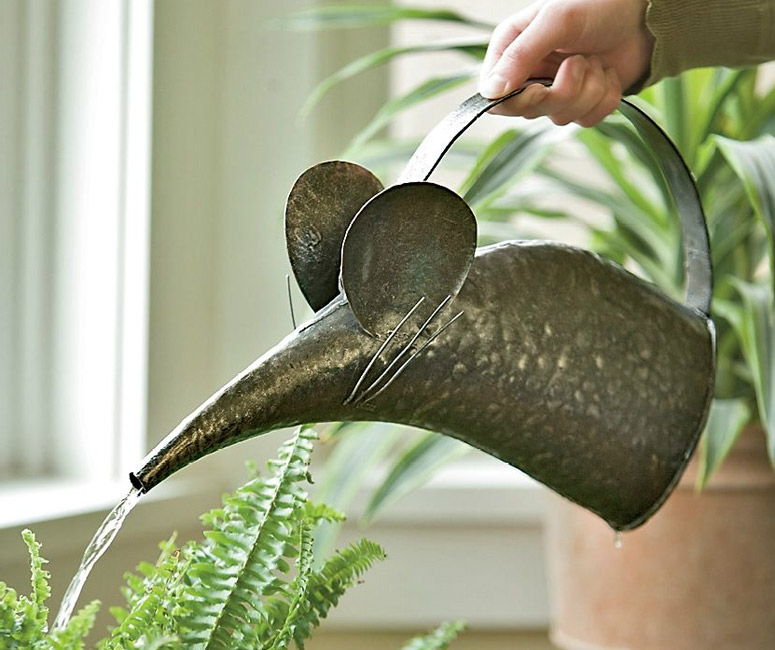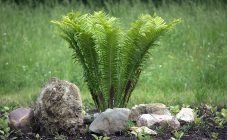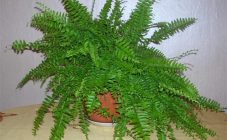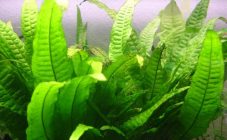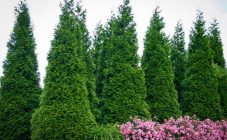Content:
The fern is one of the oldest plants in existence since the Devonian period. Then the plant had a gigantic size, now it can be grown in your country house. The fern fits perfectly into the garden landscape design.
Fern development features
Forest fern is a herbaceous plant of the Osmund family. Ferns are a division of vascular plants that includes both ancient and modern species. This is the largest group of spore plants, including about 300 genera, over 10,000 species. The homeland of the plant is the Far East, the Urals, Korea and northern China. Ferns are common in Russia and the CIS countries. More than 10 plant species grow in the Moscow region alone.
Description of the developmental features of the fern:
- The shoot at the age of 1 day has a ring-like shape, the head is underground.
- Undergrowth. On the second day, the top emerges from the ground, the rachis has a hook-like shape. At the end, there are rudiments of a flat branch (frond).
- Straightening. On the 3-4th day there is a gradual straightening, growth - up to 15-20 cm, but the top is still bent down.
- Schilze. On the 6th day, the height of the sprout reaches 20-30 cm, the thickness of the petiole is 5-8 mm. The tip is almost straightened, but the leaf blade is still compressed.
- Threesome. The shoot head unfolds, the first three petals of the leaf plate (frond) beginning to form appear. The petiole gradually acquires a fibrous structure.
The plant has almost no root, there is a horizontal stem with adventitious roots. It is the only plant without leaves. Instead of them, leaf plates (fronds) with a system of branches inside are formed from the buds of the rhizome. Twigs with frond leaves are located at the same level.
This plant also lacks seeds and reproduces by spores located on the underside of the leaf blades. Thanks to this property, ferns are able to grow in the most unfavorable conditions: in the desert, on a rock. They grow on the ground, branches and tree trunks. But fern is most often found in the forest. There are herbaceous, woody, and aquatic forms of the plant.
Fern species
For middle latitudes, the following varieties are most characteristic:
- Orlyak. The plant acquired the name (Pteridium aguillinum) for its resemblance to a huge bird's wing. The fern is represented by a stem with pinnately dissected leaves.
- Ostrich feather. The plant has several spore-bearing leaves, very similar to ostrich feathers.
- Onoclea is sensitive. It grows quickly, forming dense thickets. At the onset of the first frost, the leaves turn black and die off.
There are other types of ferns: Indoor, Indian, Forest (Bracken, Mnogoryadnik, Kochedyzhnik, Leaflet, Shitovnik), Arboreal, Male, Water.
The plant propagates by spores, dividing the bush, rhizome whiskers or offspring, brood buds.
Can I grow in the garden
Many gardeners strive to plant a plant on their site. This requires knowledge: how to grow forest fern in the garden, planting and caring for the plant.Planting material can be obtained from spores, dividing the bush, and you can also buy seedlings from an agricultural firm or a specialized store. But there is an easier way - transplanting a plant from the forest.
Transfer
The best planting material is a fern in the stage of unopened twisted leaves. The rhizome is dug up together with a lump of earth and transferred to the garden plot. To retain moisture, the rhizome must be wrapped in moss or a damp cloth. Leaves drooping before planting will no longer regain their original elasticity even after watering.
The forest fern should be planted right away in a permanent place; you should not disturb it with frequent transplants. Before replanting a fern from the forest to the site, you need to choose a suitable place with favorable conditions.
A good option is the garden tree neighborhood. The most shade-loving species is Kochedyzhnik. Eaglet and Ostrich can be planted in more illuminated places.
The plant does not like drafts and strong winds, so it is recommended to plant it along the north side of the house or any garden building. It is good if you can plant a fern near a pond or pond. However, excessive moisture causes root rot. Drainage is required - clean river sand.
The composition of the soil is not as important as the loose and light structure. A sandy loam mixture with a lot of humus is suitable for a fern, you can add peat. It is best to transplant it into the soil from the forest.
Landing technology
You can transplant the fern into the open ground in the spring, after the last frost, until the "snail" buds have opened. You can postpone planting to the end of August or the first half of September, when its active growth stops. It is not recommended to touch the foliage during the planting process.
Creeping fern (Ostrich, Eagle, Linnaeus Golokuchnik) has the ability to grow rapidly, thanks to its long rhizomes. Therefore, along the perimeter of its territory, slate, mesh or geotextiles should be buried to a depth of about 20 cm.
Algorithm of actions during transplants into open ground:
- Dig holes. The size of the planting hole should be twice the size of the root system of the seedling. It is recommended to add three drops of regular brilliant green to each hole. This will disinfect the soil. Large ferns are planted according to the 60X60 scheme, smaller ones - at a distance of 30-40 cm from each other.
- Prepare the soil from peat, sand and deciduous mixture. You can add some compost.
- The seedling is lowered into the hole, the roots are straightened, and sprinkled with soil. The soil around the fern is mulched with peat.
- The plant is watered abundantly.
Growing ferns at home requires a suitable microclimate. Indoor fern must be protected from drafts, drying out and overheating. The free volume of the pot is filled with moist sphagnum or an earthen mixture of equal parts of peat and leaf soil. Domestic ferns need to be fed with a weak aqueous solution of bird droppings twice a month. When growing a fern at home, you need to monitor the timely watering.
Fern care
Watering
The fern doesn't need much maintenance. But regular watering is very important, especially in the early months. Watering frequency is 5-7 days. In a dry summer, you cannot leave the plant without watering, as it loses its decorative effect, the leaves dry out and curl. It is good to carry out additional surface sprinkling.
Loosening
After watering, the soil must be loosened, removing weeds. To reduce moisture evaporation and weed growth, the soil is mulched with spruce needles and paws.
Top dressing is carried out using complex means, since the fern needs both organic matter and minerals during the growing season. After the leaves open, you can feed the plant by dissolving half a matchbox of bird droppings in a bucket of water.
Thinning
Ferns grow rapidly, so every second spring, old and damaged rosettes are removed.
Preparing for winter
Depending on the type of fern, some of them can easily withstand the winter, while others require shelter. The soil is mulched with straw, fallen leaves. From above, the bush is covered with a layer of straw and covering material. Leaves do not need to be cut for the winter. They will rot naturally, providing the soil with useful trace elements.
Landscape design
Ancient legends speak of the magical properties of the fern during its flowering period. In fact, the plant does not bloom, as it reproduces by spores. But the mysterious fern aura lends charm to any garden. It is widely used to create rockeries and rutaria. The openwork leaves of the plant will look great on the shore of the reservoir.
Thanks to their large, shady leaves, ferns will help hide garden imperfections. For example, the bare stems of various shrubs. To create a natural environment, the plant is placed near a fallen tree, a picturesque driftwood, stones or stump. Ferns will look good in combination with hosts, geyher, primrose, spines and corydalis.
For the arrangement of an alpine slide, the Mnogoryadnik tripartite, the adiantum stop-shaped, is suitable. For rocky fern varieties, the soil should be with the addition of crushed stone, pebbles. To deoxidize the soil, it is worth adding lime (from 50 to 80 g / m2).
When constructing compositions with long-rooted ferns, one should take into account their ability to grow rapidly. Planting varieties with short roots allows you to get neat, stable rosettes. But you should weed out periwinkle and clefthoof, which can suppress them.
Interesting. Fern not only gives beauty and aesthetic appearance to the garden, but also has a number of useful properties. Some types are used for cooking.



